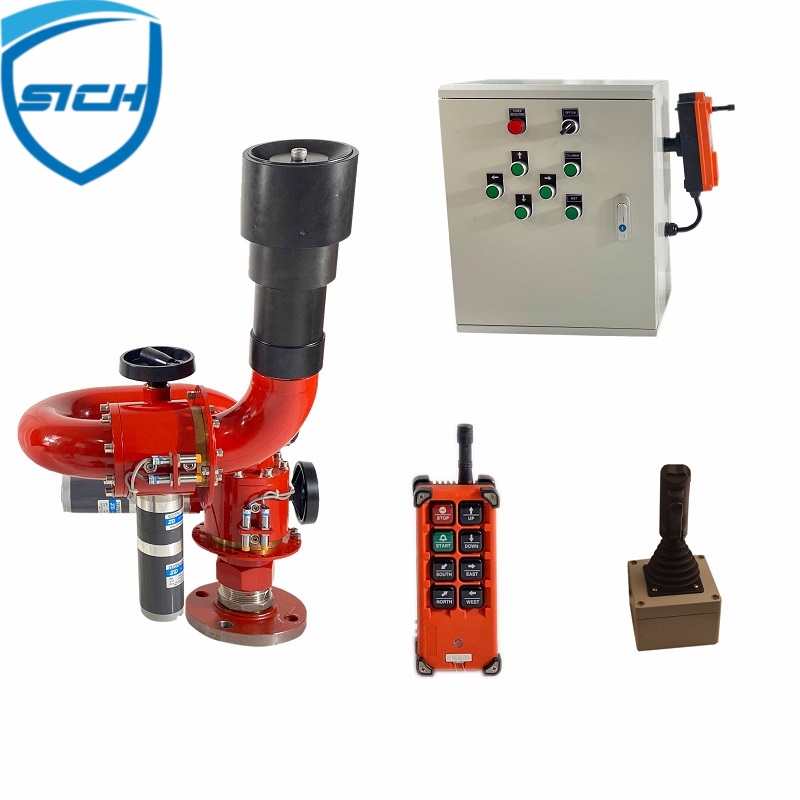Remote control fire monitors significantly enhance firefighter safety and operational effectiveness in large-scale incidents through several key ways:
- Safe Distance Operation: Firefighters can operate remote control fire monitors from a safe distance, reducing exposure to heat, flames, and hazardous environments. This minimizes the risk of injury or heat-related complications.
- Enhanced Precision and Control: Remote control technology allows precise manipulation of water direction, stream width, and flow rate. This enables firefighters to target specific areas or hotspots accurately, maximizing firefighting efficiency.
- Adaptability to Hazards: In scenarios involving hazardous materials or unstable structures, remote control fire monitors provide a safer means of firefighting without direct exposure to potential risks.
- Rapid Response: Remote control functionality enables immediate response to changing fire dynamics or emergent situations, allowing quick adjustments in water delivery without risking firefighter safety.
- Flexibility in Maneuverability: Firefighters can remotely reposition fire monitors to cover different areas, structures, or levels, adapting to evolving fire spread or changing incident requirements without entering hazardous zones.
- Maintaining Effective Operations: During large-scale incidents, remote control fire monitors ensure sustained and continuous firefighting operations without compromising on safety, allowing longer duration firefighting efforts.
- Protective Shielding: Operators can use remote control to position fire monitors to shield entry or exit points, providing protection for firefighting teams moving in or out of affected areas.
- Optimized Resource Allocation: Remote control technology enables efficient water usage by precisely directing water where it’s needed most, conserving resources and maximizing operational effectiveness.
- Improved Situational Awareness: Operators have a better view of the fire dynamics and incident scene, allowing for informed decision-making while maintaining a safe distance from the fire.
- Reduced Fatigue and Stress: By operating the fire monitors remotely, firefighters experience reduced physical strain and stress, allowing them to focus on firefighting strategies and tactics more effectively.
Overall, remote control fire monitors offer a safer and more efficient means for firefighters to combat large-scale incidents by providing targeted, controlled firefighting capabilities from a distance, minimizing risks and enhancing operational effectiveness in challenging environments.
What are the limitations or challenges associated with the use of remote control fire monitors in firefighting?
While remote control fire monitors offer significant advantages, they also come with certain limitations and challenges:
- Dependency on Technology: Remote control systems rely on technology, and any malfunction or technical issues could hinder or disrupt firefighting operations. Power failures, signal interference, or system failures might occur, impacting the monitor’s operation.
- Training and Familiarity: Firefighters need adequate training and familiarity with remote control systems to operate them effectively. Inexperienced or insufficiently trained personnel may struggle to utilize the equipment optimally during emergencies.
- Range and Signal Interference: Remote control range limitations or signal interference, particularly in complex or obstructed environments, remote control fire monitor can restrict the monitor’s effective operation, reducing its usability in certain scenarios.
- Battery Life and Power Supply: Remote control systems rely on power sources, and battery life or power availability may limit the duration of remote operations. Extended operations might require additional power sources or backup systems.
- Maintenance and Reliability: Regular maintenance is crucial for remote control systems to ensure their reliability. Failure to conduct proper upkeep may lead to system malfunctions or reduced performance during critical firefighting situations.
- Environmental Conditions: Extreme weather conditions, such as heavy rain, extreme temperatures, or high winds, can impact the functionality of remote control systems, affecting signal transmission and overall operation.
- Security Concerns: Remote control systems might be vulnerable to hacking or unauthorized access, posing potential security risks or the risk of malicious interference during firefighting operations.
- Complexity of Operation: In high-stress or emergency situations, operating remote control systems might become challenging due to the complexity of controls or the need for rapid decision-making, potentially affecting operational efficiency.
- Cost and Accessibility: The initial investment and maintenance costs for remote control systems might be significant, limiting accessibility for smaller fire departments or organizations with budget constraints.
- Integration with Existing Systems: Integrating remote control fire monitors with existing firefighting equipment or systems might require compatibility considerations or additional modifications, posing challenges during implementation.
Despite these challenges, advancements in technology and proper training can mitigate many limitations associated with remote control fire monitors, improving their effectiveness and reliability in firefighting operations. Regular testing, maintenance, and addressing potential vulnerabilities can help overcome these challenges and enhance the utility of remote-controlled firefighting equipment.

